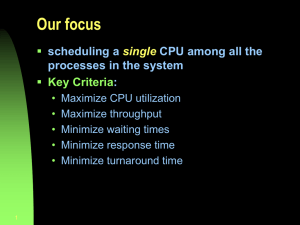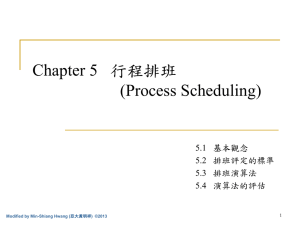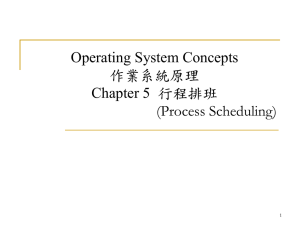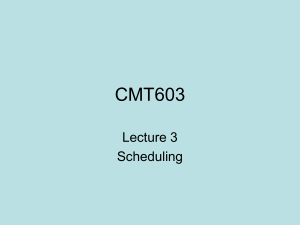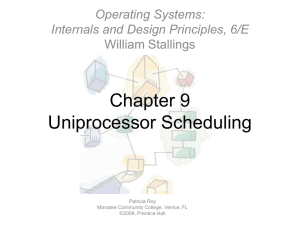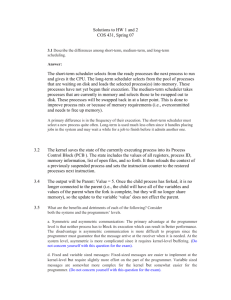May 14 - Process Scheduling part 1
advertisement
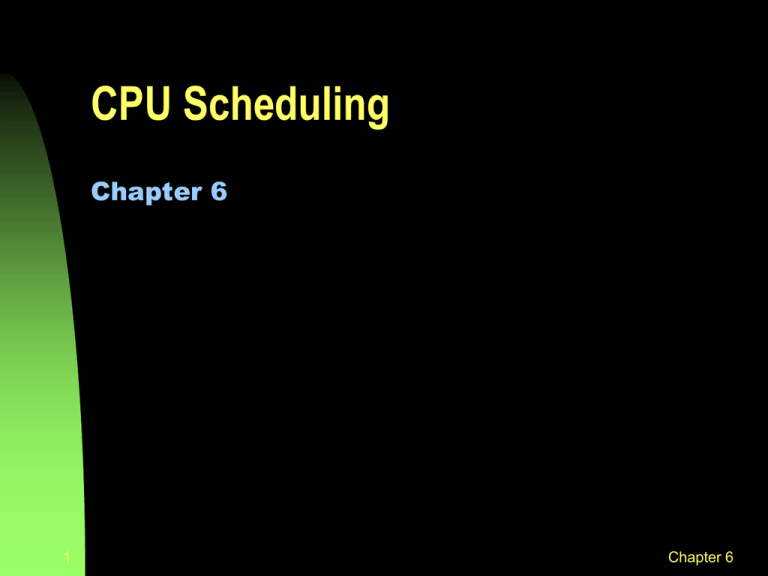
CPU Scheduling Chapter 6 1 Chapter 6 Classification of Scheduling Activity 2 Long-term: which process to admit Medium-term: which process to swap in or out Short-term: which ready process to execute next Long-Term Scheduling Determines which programs are admitted to the system for processing Controls the degree of multiprogramming If more processes are admitted • less likely that all processes will be blocked • better CPU usage • each process has smaller fraction of the CPU The long term scheduler may attempt to keep a mix of processor-bound and I/Obound processes 3 Medium-Term Scheduling Swapping decisions based on the need to manage multiprogramming • Allows the long-term scheduler to admit more processes than actually fit in memory • but too many processes can increase disk activity (paging), so there is some “optimum” level of multiprogramming. Done by memory management software (chapter 8) 4 Short-Term Scheduling Determines which process is going to execute next (also called CPU scheduling) the focus of this chapter.. invoked on a event that may lead to choosing another process for execution: • clock interrupts • I/O interrupts • operating system calls and traps, including I/O • signals 5 The CPU-I/O Cycle “CPU-bound” processes require more CPU time than I/O time “I/O-bound” processes spend most of their time waiting for I/O. Silberschatz, Galvin, and Gagne 1999 6 Histogram of CPU-burst Times Silberschatz, Galvin, and Gagne 1999 7 Our focus Uniprocessor Scheduling: scheduling a single CPU among all the processes in the system Key Criteria: • • • • • 8 Maximize CPU utilization Maximize throughput Minimize waiting times Minimize response time Minimize turnaround time Criteria Maximize CPU utilization • Efficiency • Need to keep the CPU busy Minimize waiting times • Time spent waiting in READY queue • Each process should get a fair share of the CPU 9 Criteria Maximize throughput • Process completions per time unit Minimize response time • From a user request to the first response • I/O bound processes Minimize turnaround time • CPU-bound process equivalent of response time • Elapsed time to complete a process 10 User vs. System Scheduling Criteria User-oriented Turnaround Time (batch systems): Elapsed time from the submission of a process to its completion Response Time (interactive systems): Elapsed time from the submission of a request to the first response System-oriented CPU utilization fairness throughput: processes completed per unit time 11 Two Components of Scheduling Policies Selection function which process in the ready queue is selected next for execution? Decision mode at what times is the selection function exercised? • Nonpreemptive A process in the running state runs until it blocks or ends • Preemptive Currently running process may be interrupted and moved to the Ready state by the OS Prevents any one process from monopolizing the CPU 12 Policy vs. Mechanism Important in scheduling and resource allocation algorithms Policy • What is to be done Mechanism • How to do it 13 Policy: All users equal access Mechanism: round robin scheduling Policy: Paid jobs get higher priority Mechanism: Preemptive scheduling algorithm A running example to discuss various scheduling policies Arrival Time Burst Time 1 0 3 2 2 6 3 4 4 4 6 5 5 8 2 Process 14 First Come First Served (FCFS) Selection function: the process that has been waiting the longest in the ready queue (hence, FCFS, FIFO queue) Decision mode: nonpreemptive • a process runs until it blocks itself (I/O or other) 15 FCFS Drawbacks Favors CPU-bound processes • A process that does not perform any I/O will monopolize the processor! • I/O-bound processes have to wait until CPUbound process completes • They may have to wait even when their I/Os have completed poor device utilization • We could reduce the average wait time by giving more priority to I/O bound processes 16 Shortest Job First (SJF) Shortest job First (SJF) Selection function: the process with the shortest expected CPU burst time Decision mode: non-preemptive I/O bound processes will be picked first We need to estimate the expected CPU burst time for each process: on the basis of past behavior. 17 Estimating the Required CPU Burst Can average all past history equally But recent history of a process is more likely to reflect future behavior A common technique for that is to use exponential averaging • S[n+1] = a T[n] + (1-a) S[n] ; 0 < a < 1 • Puts more weight on recent instances whenever a > 1/n 18 Exponentially Decreasing Coefficients 19 Exponential Averaging Set S[1] = 0 to give new processes high priority. Exponential averaging tracks changes in process behavior much faster than simple averaging. 20 Shortest Job First: Critique SJF implicitly incorporates priorities: shortest jobs are given preference. • Typically these are I/O bound jobs Longer processes can starve if there is a steady supply of shorter processes Lack of preemption not suitable in a time sharing environment • CPU bound process gets lower priority • But a process doing no I/O at all could monopolize the CPU if it is the first one in the system 21 Shortest Remaining Time (SRT) = Preemptive SJF If a process arrives in the Ready queue with estimated CPU burst less than remaining time of the currently running process, preempt. Prevents long jobs from dominating. • But must keep track of remaining burst times Better turnaround time than SJF • Short jobs get immediate preference 22 Round-Robin Selection function: same as FCFS Decision mode: Preemptive • Maximum time slice (typically 10 - 100 ms) enforced by timer interrupt • running process is put at the tail of the ready queue 23 Time Quantum for Round Robin 24 must be substantially larger than process switch time should be larger than the typical CPU burst If too large, degenerates to FCFS Too small, excessive context switches (overhead) Fairness vs. Efficiency Each context switch has the OS using the CPU instead of the user process • give up CPU, save all info, reload w/ status of incoming process • Say 20 ms quantum length, 5 ms context switch • Waste of resources 20% of CPU time (5/20) for context switch • If 500 ms quantum, better use of resources 1% of CPU time (5/500) for context switch Bad if lots of users in system – interactive users waiting for CPU • Balance found depends on job mix 25 Round Robin: Critique Still favors CPU-bound processes • An I/O bound process uses the CPU for a time less than the time quantum and then is blocked waiting for I/O • A CPU-bound process runs for its whole time slice and goes back into the ready queue (in front of the blocked processes) One solution: virtual round robin (VRR, not in book…) • When a I/O has completed, the blocked process is moved to an auxiliary queue which gets preference over the main ready queue • A process dispatched from the auxiliary queue gets a shorter time quantum (what is “left over” from its quantum when it was last selected from the ready queue) 26
